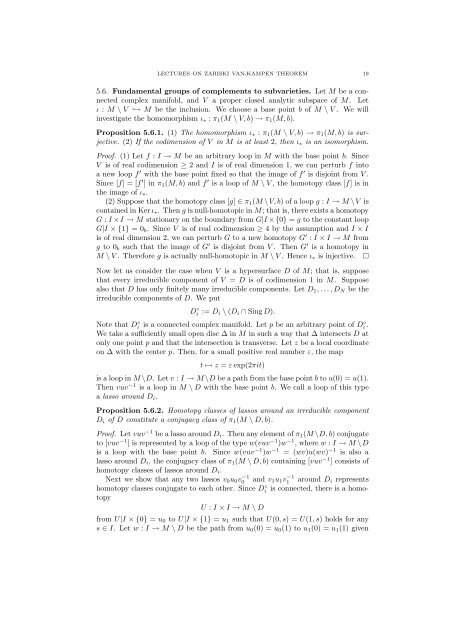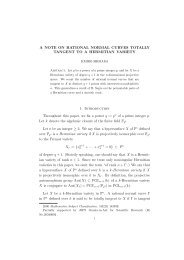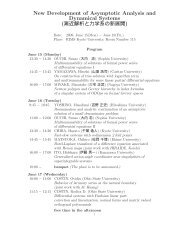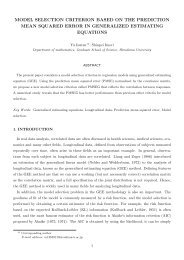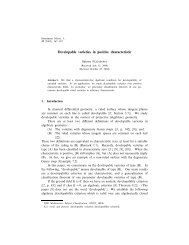LECTURES ON ZARISKI VAN-KAMPEN THEOREM 1. Introduction ...
LECTURES ON ZARISKI VAN-KAMPEN THEOREM 1. Introduction ...
LECTURES ON ZARISKI VAN-KAMPEN THEOREM 1. Introduction ...
You also want an ePaper? Increase the reach of your titles
YUMPU automatically turns print PDFs into web optimized ePapers that Google loves.
<strong>LECTURES</strong> <strong>ON</strong> <strong>ZARISKI</strong> <strong>VAN</strong>-<strong>KAMPEN</strong> <strong>THEOREM</strong> 19<br />
5.6. Fundamental groups of complements to subvarieties. Let M be a connected<br />
complex manifold, and V a proper closed analytic subspace of M. Let<br />
ι : M \ V ↩→ M be the inclusion. We choose a base point b of M \ V . We will<br />
investigate the homomorphism ι ∗ : π 1 (M \ V,b) → π 1 (M,b).<br />
Proposition 5.6.<strong>1.</strong> (1) The homomorphism ι ∗ : π 1 (M \ V,b) → π 1 (M,b) is surjective.<br />
(2) If the codimension of V in M is at least 2, then ι ∗ is an isomorphism.<br />
Proof. (1) Let f : I → M be an arbitrary loop in M with the base point b. Since<br />
V is of real codimension ≥ 2 and I is of real dimension 1, we can perturb f into<br />
a new loop f ′ with the base point fixed so that the image of f ′ is disjoint from V .<br />
Since [f] =[f ′ ]inπ 1 (M,b) and f ′ isaloopofM \ V , the homotopy class [f] isin<br />
the image of ι ∗ .<br />
(2) Suppose that the homotopy class [g] ∈ π 1 (M \V,b) ofaloopg : I → M \V is<br />
contained in Ker ι ∗ . Then g is null-homotopic in M; that is, there exists a homotopy<br />
G : I ×I → M stationary on the boundary from G|I ×{0} = g to the constant loop<br />
G|I ×{1} =0 b . Since V is of real codimension ≥ 4 by the assumption and I × I<br />
is of real dimension 2, we can perturb G to a new homotopy G ′ : I × I → M from<br />
g to 0 b such that the image of G ′ is disjoint from V . Then G ′ is a homotopy in<br />
M \ V . Therefore g is actually null-homotopic in M \ V . Hence ι ∗ is injective.<br />
Now let us consider the case when V is a hypersurface D of M; that is, suppose<br />
that every irreducible component of V = D is of codimension 1 in M. Suppose<br />
also that D has only finitely many irreducible components. Let D 1 ,...,D N be the<br />
irreducible components of D. We put<br />
Di ◦ := D i \ (D i ∩ Sing D).<br />
Note that Di ◦ is a connected complex manifold. Let p be an arbitrary point of D◦ i .<br />
We take a sufficiently small open disc ∆ in M in such a way that ∆ intersects D at<br />
only one point p and that the intersection is transverse. Let z be a local coordinate<br />
on ∆ with the center p. Then, for a small positive real number ε, the map<br />
t ↦→ z = ε exp(2πit)<br />
is a loop in M \D. Let v : I → M \D be a path from the base point b to u(0) = u(1).<br />
Then vuv −1 isaloopinM \ D with the base point b. We call a loop of this type<br />
a lasso around D i .<br />
Proposition 5.6.2. Homotopy classes of lassos around an irreducible component<br />
D i of D constitute a conjugacy class of π 1 (M \ D, b).<br />
Proof. Let vuv −1 be a lasso around D i . Then any element of π 1 (M \D, b) conjugate<br />
to [vuv −1 ] is represented by a loop of the type w(vuv −1 )w −1 , where w : I → M \ D<br />
is a loop with the base point b. Since w(vuv −1 )w −1 = (wv)u(wv) −1 is also a<br />
lasso around D i , the conjugacy class of π 1 (M \ D, b) containing [vuv −1 ] consists of<br />
homotopy classes of lassos around D i .<br />
Next we show that any two lassos v 0 u 0 v0 −1 and v 1 u 1 v1 −1 around D i represents<br />
homotopy classes conjugate to each other. Since Di ◦ is connected, there is a homotopy<br />
U : I × I → M \ D<br />
from U|I ×{0} = u 0 to U|I ×{1} = u 1 such that U(0,s)=U(1,s) holds for any<br />
s ∈ I. Let w : I → M \ D be the path from u 0 (0) = u 0 (1) to u 1 (0) = u 1 (1) given


